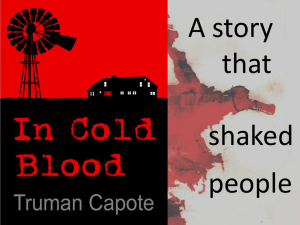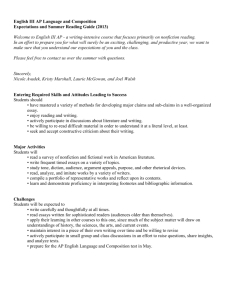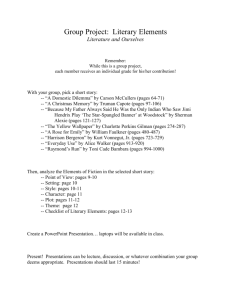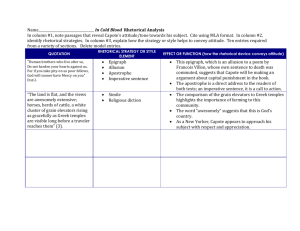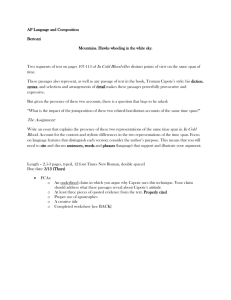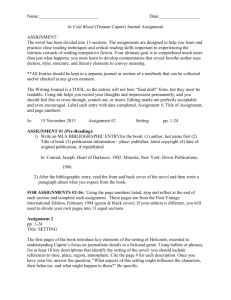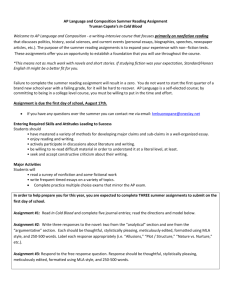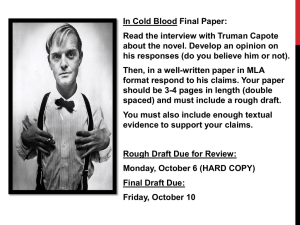Concept Analysis
advertisement
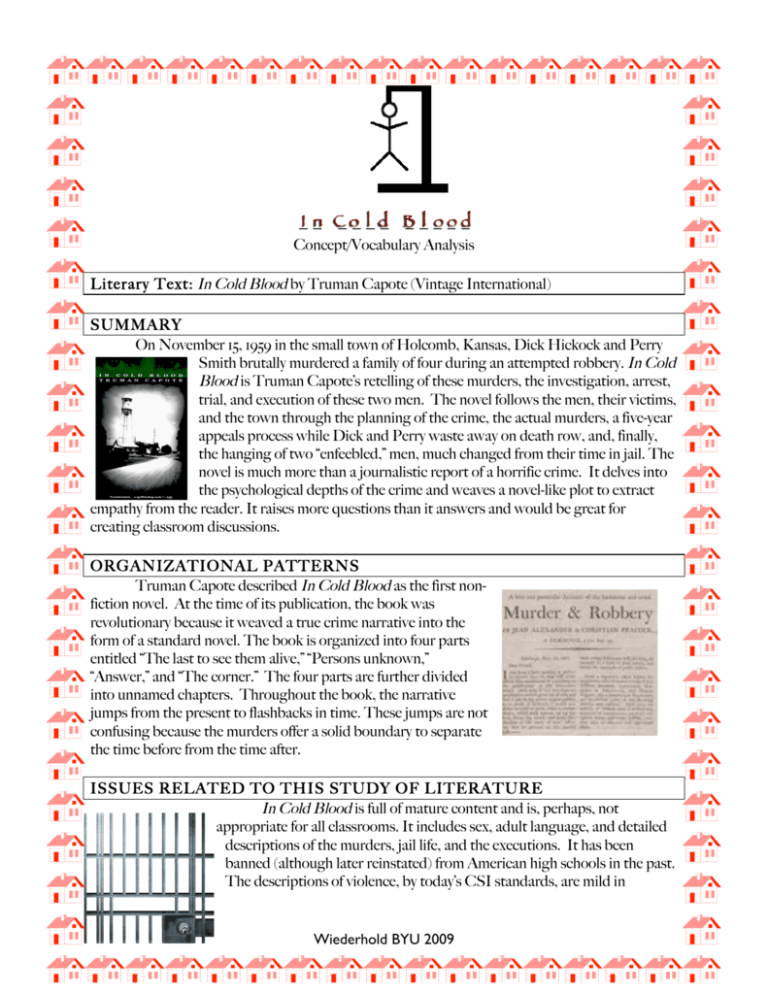
Concept/Vocabulary Analysis Literary Text: In Cold Blood by Truman Capote (Vintage International) SUMMARY On November 15, 1959 in the small town of Holcomb, Kansas, Dick Hickock and Perry Smith brutally murdered a family of four during an attempted robbery. In Cold Blood is Truman Capote’s retelling of these murders, the investigation, arrest, trial, and execution of these two men. The novel follows the men, their victims, and the town through the planning of the crime, the actual murders, a five-year appeals process while Dick and Perry waste away on death row, and, finally, the hanging of two “enfeebled,” men, much changed from their time in jail. The novel is much more than a journalistic report of a horrific crime. It delves into the psychological depths of the crime and weaves a novel-like plot to extract empathy from the reader. It raises more questions than it answers and would be great for creating classroom discussions. ORGANIZATIONAL PATTERNS Truman Capote described In Cold Blood as the first nonfiction novel. At the time of its publication, the book was revolutionary because it weaved a true crime narrative into the form of a standard novel. The book is organized into four parts entitled “The last to see them alive,” “Persons unknown,” “Answer,” and “The corner.” The four parts are further divided into unnamed chapters. Throughout the book, the narrative jumps from the present to flashbacks in time. These jumps are not confusing because the murders offer a solid boundary to separate the time before from the time after. ISSUES RELATED TO THIS STUDY OF LITERATURE In Cold Blood is full of mature content and is, perhaps, not appropriate for all classrooms. It includes sex, adult language, and detailed descriptions of the murders, jail life, and the executions. It has been banned (although later reinstated) from American high schools in the past. The descriptions of violence, by today’s CSI standards, are mild in Wiederhold BYU 2009 comparison, dealing more with internal character development rather than external actions. THEME American Epic Tragedy Capote makes reference to Greek and Shakespearean tragedies within the first two paragraphs of his novel. The references, although subtle and indirect, give readers a clue to Capote’s intentions. For Capote, the nonfiction novel allowed him to elevate and set as a standard this isolated incident as exemplary of a larger, true American experience. And like Shakespeare’s Hamlet, Capote successfully blurs the lines between insanity, revenge, motivation, sexuality, and even reality. As Capote described it, this novel moves and explores vertically while the plot keeps marching horizontally through time until two men find themselves at the end of their rope. Capital Punishment Ironically, even though Dick and Perry are on death row, Capote does a masterful job of humanizing the men, and when Perry refuses to eat on death row the reader may find a small hope that he will pull through and recover. At the end of the novel, Perry is portrayed as a small boy, innocent, dangling from the gallows. Although never directly stated as such, Capote’s depiction can be taken as an argument against capital punishment. Indeed, the reader may even question whether the title In Cold Blood refers to the original murders or the hangings. Disillusionment Rural America is no longer safe. Evil has pervaded even the smallest most remote ‘out there’ parts of America in Capote’s book. The novel opens with a changed, shocked town. Neighbors no longer trust each other, women are buying locks (any and all locks to secure their doors), banks and business owners are compromised by Dick’s fraudulent checks, and typically compassionate nuns are portrayed as child abusers. In short, the town of Holcomb, and by representation America at large, has stopped dancing. The time of innocence has passed. Violence in America Capote argues that of all the people in the entire world the Clutters were the least likely to be murdered. And even more so, of all the people in the world to commit their murders, Dick and Perry were the least likely suspects, meaning simply that these two men seemed to have no motivation for the murder. They were normal enough men. Corrupted? Yes, but certainly not what is typically associated with gangster type violence. Dick and Perry were not murderers but they were two men made capable of murder through circumstance. All Americans could likewise become capable of such violence. Wiederhold BYU 2009 American Family Values “Feeling wouldn’t run quite so high if this had happened to anyone except the Clutters, anyone less admired, prosperous, secure. That family represented everything that people here really value and respect… and such a thing could happen to them. Well it’s like telling them there is no God.” The Clutters’ innocence and good living did not protect them. Capote’s tragedy is created around the beloved and cherished American values that were so prevalent during the fifties. The age of modernity, and progress has also brought a decline of another kind. The Corruptive Power of Obsession The detective, Alvin Dewey, is obsessed with the case and with capturing the killers. He brings crime scene photos into his home, answers phone calls at all hours of the night against his wives protestations, and, in his wife’s words, abandons what was a normal life to pursue this case. He is consumed with solving the crime and almost destroys himself and his family to fulfill his obsession. And ultimately at the end of the novel Capote presents Dewey as the prodding force behind the executions rather than the state as a whole. It is as if Dewey has turned into the murderer. CHARACTER FOILS Mr. Clutter and his family are directly contrasted with Dick and Perry. In every way, Mr. Clutter and his family represent wholesome America. Dick and Perry represent a damaged America. Comparing and contrasting these character sets could help students understand how Capote crafted a novel from facts. For example, Mr. Clutter always writes checks, even for a $1.50 haircut. Dick also always writes checks, however his are fraudulent and used to cheat and steal from innocent store managers. In one instance, he writes a check for $80 over the value of a necklace, takes the necklace and the $80 in cash, pawns the necklace, and makes away with that money as well. SETTING The novel is set in the area surrounding Holcomb, Kansas. At the time of the novel, Holcomb was a village of around two hundred people. Capote, of course, couldn’t choose his setting because the novel is based on true events; however, Capote uses the rural location to bring urban themes into rural America. He paints a picture of a disillusioned town no longer safe enough to leave doors unlocked. The people of Holcomb begin to distrust each other, as if no place in America can escape twentieth century violence. The rural setting is also interesting since he uses the expansive fields surrounding the village to suggest that Holcomb, and what it represents, can be seen from great distances. Suddenly rural America is center stage. Wiederhold BYU 2009 POINT OF VIEW, NARRATIVE VOICE Capote claimed that every word of his novel is true. He manages to avoid inserting himself into the story. Nowhere is Capote found in the book; yet, upon reflection, it can be argued that Capote is everywhere in the book. Capote researched the novel for five years and never took any notes on his interviews. He relied instead on his uncanny memory and ability to recall conversations. But no matter how good his memory is, the novel includes details that are absolutely impossible to be a genuine report (for example, the quoted words that Mr. Clutter spoke in the presence of his wife before the murderers or any other surviving witnesses are present). Though this style has become quite routine in literature and media today, writing fiction which was “based on true events” was Capote’s way of breaking new ground at the time. He used an intense understanding of the characters involved to justify the creation of authentic dialogue and details where there were none provided to him. AFFECTIVE ISSUES RELATED TO THE WORK Students might have a hard time relating to the book and specifically to the characters of Perry and Dick if they are only viewed as murderers. However, the book speaks from the perspective of the outsider. Capote, although quite famous during his day, was a flagrant homosexual and was not a stranger to feeling like an outsider. He presents Perry in a way that I think teenagers can relate to. Perry is awkward, confused, damaged, and above all still searching for an identity. He is not presented as completely innocent but certainly possessing a level of innocence because of his confused identity and the lack of love during his upbringing. IMPLICATIONS FOR STUDENT DIVERSITY There is little ethnic diversity in this book. It takes place in a village of approximately two hundred people and focuses mainly on a few isolated individuals. However, Perry is presented as half-Indian and was called “nigger” by the nuns who raised and abused him. Capote presents the town as a compilation of Germans, Swedes and various other immigrant groups in an attempt to make this one town representative of all towns, but the reference is only to create the metaphor and is not truly representative. VOCABULARY As mentioned, the book contains a few uses of the word “nigger.” This issue should probably be addressed before reading the book. Overall, the vocabulary is not too difficult and should be accessible for bright, upper secondary students. It may, however, be helpful to review a few dated words (e.g. parson, gallows, Spartan (simple) etc.). It will also be necessary to review some agrarian terms for those not familiar with ‘growin’ up on the farm’ (e.g. prairie, stetson (hat), grain elevator, rawhide, 4-H, county-seat, tumbleweed, “dry-county” (alcohol free), Tom Sawyer, southern belle, Indian summer, Wiederhold BYU 2009 mongrel, Quonset hut, maize, Hereford (type of cow), etc.) The vocabulary is not so distracting that it would detract from a student’s ability to gain meaning from the text, but the novel does contain college level, if not obscure, words here and there (‘pugnacity’, ‘profundity,’ etc.). Percy especially is quite intelligent and uses large words. There is even a scene where he finds a journal entry that contains a list of words that he finds beautiful. He reads the list but also provides each word a definition as transcribed from the dictionary. BACKGROUND KNOWLEDGE In today’s crime show-abundant television world, students are exposed to violence and crime in a pervasive way and may be somewhat desensitized to the descriptions in Capote’s novel. It may be helpful to review the time period and understand the moral climate (especially for rural America), the exposure that the people of Holcomb would have had with this type of crime and even the level of exposure the rest of the country had at the time of the publication of this novel. It may also be helpful to review the history of the death penalty and the arguments surrounding cruel and unusual punishment. THE CENTRAL QUESTION/ENDURING ISSUE What is the line between right and wrong? Obviously the book involves a criminal trial, but the book explores this issue well past the obvious line of guilt and innocent as proven in a court of law. For example, a few hours before Mr. Clutter is murdered he signs up for a life insurance policy with double indemnity. When the insurance agent hears of the murder, he has not yet cashed Mr. Clutter’s check for the first payment, making him legally exempt from having to fulfill the terms of the policy (a hefty sum), but he notes the morally correct thing to do is to fulfill the policy. The book makes it clear that there are moral laws that transcend and perhaps even subvert the legal laws of the land, including the fulfillment of capital punishment. Is Capital punishment ethical? (or the respect for human life in general) The book explores, and perhaps proves, that Dick and Perry are not wholly in control of their mental faculties. Perry is portrayed as a victim of abuse; he tries to kill himself, seems incapable of controlling his anger (an anger unnaturally provoked), and above all is portrayed as being full of childlike innocence right up until his execution. Yet, this all being true, Perry and Dick themselves wonder with a sense of incredulity if they will really be allowed to get away with what they have done. It is as if they believe they should be punished and perhaps even hope for that. If the reader is not Wiederhold BYU 2009 persuaded that capital punishment is inhumane, then the book offers the argument that the act of hanging is, and by extension humankind are poor judges of what is a humane punishment (e.g. the officers believe that hanging is a painless death for the victim; however, it takes twenty minutes for the doctor to pronounce death, the victim gasping for breath much of the time). While some may argue that the hangings concern only a few pages of the entire work, it can be argued that the rest of the book is there to frame an understanding for the final killings. PROJECT IDEAS Debate (public speaking/research) After class discussion, students can take sides regarding capital punishment. Students can research famous cases, as well as this one. They can then come together for a debate to present their research. Students listening can score the debaters for both their effectiveness as speakers and the persuasiveness of their information. The project could also serve to help students practice research as much as oral speaking. Finally, this project can be used to help students evaluate the effectiveness of resources. Profiling The FBI uses profiling to create psychological profiles of criminals including motivation, upbringing, and possible future actions, all from isolated crime evidence. In the novel, Perry reads a Reader’s Digest article entitled, “How good a character detective are you?” The article talks about how characters’ internal make-up can be determined by external signs (a stiff walk can signal a stubborn personality, etc.). In today’s crime and television shows, this is an extremely popular theme. Dr. House can diagnose anyone, both psychologically and medically, by these small clues. There is an entire show entitled “Lie to me” where the premise is that it is impossible to hide your internal motivations because all of the external actions and micro-expressions of your facial muscles, body language, etc. give away the truth of your guilt or innocence. For this project, students could create character profiles for Dick, Perry, and perhaps even Dewey or Mr. Cutter. The book relies on these types of clues to develop the characters (e.g. Mr. Cutter always uses checks and never carries cash because he is perpetually preparing for the tax man to come knocking on his door). Perry’s character is by far the most developed and would provide heavy fodder for this activity (e.g. his dreams, ripping his glove, correcting Wiederhold BYU 2009 grammar, getting stockings from the nuns, love of the taste of aspirin, etc.) The project could be developed into a formal essay or just remain as a practice in looking for clues within the text. ENRICHMENT RESOURCES There have been many film adaptations Movies made from Capote’s original book. The first is a Richard Brooks adaptation made in 1967; and the latest film “Capote” is an adaptation of a book by Gerald Clark of the same title. This latest version focuses on the life of Truman Capote himself while writing the book; and it is rated R. YOUTUBE There are short interviews with Truman Capote available on YouTube: http://www.youtube.com/watch?v=LkzeGpGNhRs entitled: Retrobites: Capote's NonFiction Novel (1966) In this interview Capote discusses the non-fiction novel. http://www.youtube.com/watch?v=Xe1cqDLkT38&feature=channel entitled: Retrobites: Capote in Kansas (1966) In this interview he describes how the town of Holcomb first received Him Websites: http://www.capotebio.com/ Wiederhold BYU 2009
